10 Benefits of Flexible Working Hours for Employees
Flexible working hours offer numerous benefits for employees, including improved work-life balance, reduced stress, increased productivity, and better job satisfaction. Learn more about the advantages of flexible schedules.

According to the 2016 Forbes report, 91% of HR professionals realized that flexible working hours helped employees be more satisfied and productive.
It marked an early recognition of what would become a cornerstone of modern flexible workplace culture.

What Does Flexibility at Work Look Like?
The evolution of workplace flexibility has expanded from remote work to provide multiple ways employees can balance their work lives.
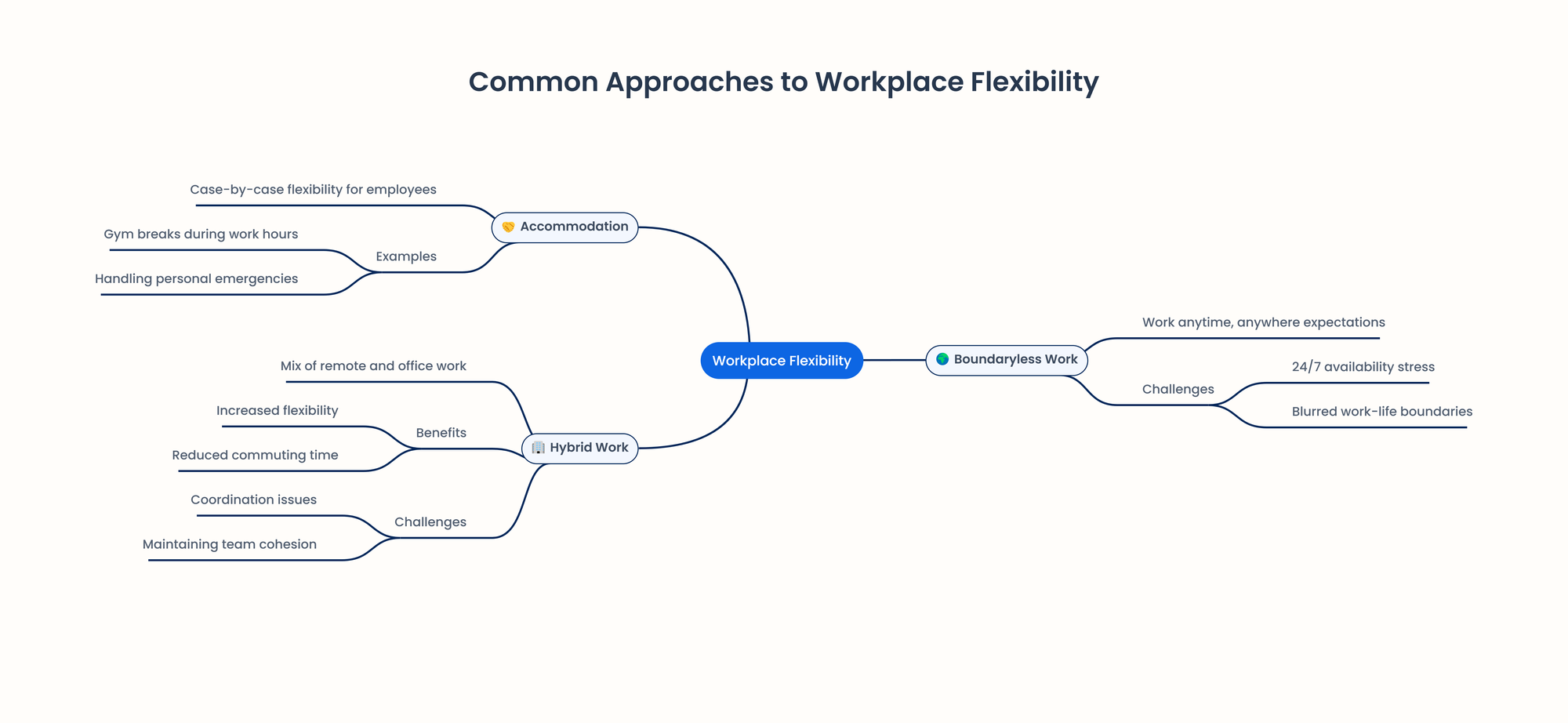
Modern organizations typically implement flexibility through three frameworks.
The accommodation model lets employees customize their workdays to handle personal activities (for example, gym breaks, and personal emergencies) without changing standard business schedules.
⭐This model allows the organization to quickly respond to unexpected situations.
The liberating concept of boundaryless work lets employees choose when and where they work but it needs strong supervision to avoid burnout and maintain a work-life balance.
⭐It enables teams to work across different time zones and locations, fostering a more global and diverse workforce. It also ensures that the business can operate around the clock, providing better service to customers in different time zones.
The hybrid work model blends office time and remote work hours to maintain workplace connections for teams while reducing travel needs and giving staff the freedom they need.
⭐It combines the benefits of remote work (such as reduced commuting) with the advantages of in-person collaboration (such as team-building and brainstorming sessions). It also provides a balance between flexibility and structure, ensuring that employees have clear expectations and routines.
Other Flexible Models
Remote-First Work prioritizes remote work as the primary mode of operation. Organizations are structured to support remote employees fully, often with tools and practices that facilitate collaboration and communication without the need for a physical office.
Results-Only Work Environment (ROWE) is designed to evaluate workers on their achievements without considering how many hours they spend on their tasks. Workers can work from anywhere and at any time to focus on delivering results through this program.
Flextime allows team members to decide when they work during the day as long as they maintain their designated work hours. Workers have the freedom to adjust their daily work hours to meet their personal commitments and maintain an improved balance between work and their personal life.
Job Sharing implies that two team members divide a complete full-time job between themselves. Shortened work schedules for multiple staff members enable proper job coverage.
Compressed Workweeks means that the team breaks their regular weekly duties into fewer working days by swapping ten-hour shifts during four days of work instead of conducting eight-hour shifts across five workdays. The plan offers a healthier work-life balance through extended Saturdays and Sundays.
Part-Time Work belongs to flexible models since staff members split their work into less than a typical full-time workweek. This schedule option lets workers manage their jobs alongside their family needs and educational requirements.
Every flexible working time strategy requires careful setup followed by clear rules to employees along with a continuous assessment of policy to manage and support both business aims and workforce performance.
10 Benefits of Flexible Work Arrangements
The option to set flex time at work helps workers and their employers succeed. The following benefits explain all advantages through direct insights for business owners and HR managers.
Benefits for Employees
1. Improved Work-Life Balance
Workers can take better care of their personal lives while maintaining appropriate work coverage with flexible schedules.
Teams work better and stay motivated longer when they find healthy ways to separate work from their personal lives.
2. Increased Job Satisfaction
People feel more connected to their jobs when they can choose their work time and schedule, – it helps employees feel trusted and enhance engagement.
3. Reduced Commute
When staff work remotely they use less transport and save time and money through reduced commuting requirements.
Urban employees gain maximum advantage from this option due to their distance-driven expenses and lengthy travel times.
4. Better Health and Well-Being
People with flexible work options show better health results because they can allocate time to exercise, rest, and attend to personal needs.
A healthier workforce reports to work more effectively while delivering higher productivity.
5. Enhanced Productivity
People get better work results when they can improve their self-scheduling with tools like TMetric and work at optimal times and in their preferred workspace.
When staff can adjust their working hours they focus better and achieve higher quality results.
Benefits for Employers
6. The Ability to Draw and Keep Skilled Workers
By providing flexible work arrangements companies become more appealing to potential employees and keep dedicated staff satisfied.
Starting a flexible work policy with remote options allows companies to get the best employees and save money on hiring and retention.
7. Gains
When employees enjoy their work and remain focused throughout their day they create valuable contributions that boost company success.
Employees will perform better when they have the freedom to choose their work hours which boosts office morale.

8. Cost Savings
With fewer offices, the associated costs of the organization are reduced, along with minimized workplace maintenance costs.
Businesses that move to remote work can reduce their physical workspace and save money through reduced office costs including rents and utility bills.
9. Access to a Wider Talent Pool
Remote working lets companies find top candidates from any part of the world without office location barriers.
Businesses that employ workers beyond local borders can recruit better-qualified staff which strengthens their market position.
10. Improved Employee Morale
Trusting employees with adaptable working schedules creates happier workers who stay longer with companies.
When employees stay motivated and positive they work better in groups and enjoy their workplace more.
Benefits for the Organization
Enhanced Innovation
When employees come from varied backgrounds, they generate better ideas through diverse thought processes. A range of work options and team differences produce innovative outcomes and an energetic workplace.

Better Crisis Preparedness
An organization equipped for flexible work is more resilient to major disruptions since they maintain remote work protocols. This system lets businesses operate continuously and reduces time without service.
Environmental Benefits
Organizations achieve sustainability objectives by reducing employee travel time which helps lower environmental impact. Remote work policies show companies support both environmental care and sustainable practices.
How to Measure Success of Flexible Work Strategies
The results of flexible work strategies need metrics and measurement because the data shows real performance effects and helps us decide smartly.
Quantitative Performance Metrics
Project Completion Rates: Follow how many projects reach their finished date on schedule.
Customer Satisfaction Scores: Track what clients think and how they rate service.
Response Times: See how fast your team answers client questions or service tickets.
Employee Performance Data
Meeting Deadlines: Keep a record of projects done within deadlines without failure.
Quality of Deliverables: Check if team works to meet established criteria for quality.
Goal Scores: See how actual results match up to your planned targets.
Employee Well-Being Data Metrics
Job Satisfaction: Ask employees quick survey questions.
Work-Life Balance: Review how work duties and personal schedules match.
Employee Retention Rates: Track the workers who skip work or need to take medical leave.
Participation in Wellness Initiatives: Study which team members sign up for health and training programs.
Operational Efficiency Metrics
Cost Savings: Tracks utility expenses.
Technology Adoption Rates: Monitor how employees use digital tools and web platforms.
Meeting Effectiveness: Review meeting duration patterns and see who joins and participates in meetings.
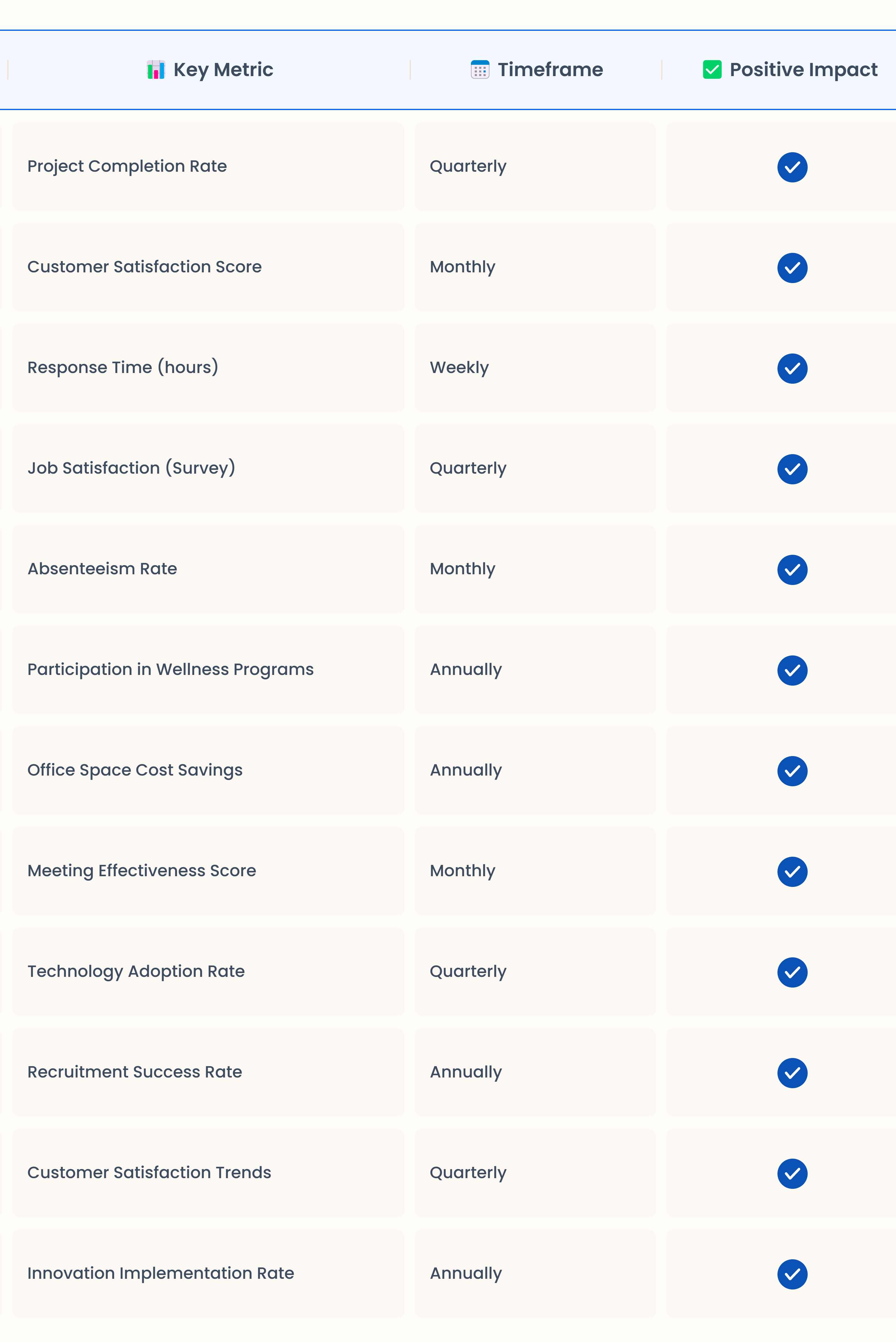
Here are some practical methods to evaluate the effectiveness of flexible work arrangements.
Employee Surveys
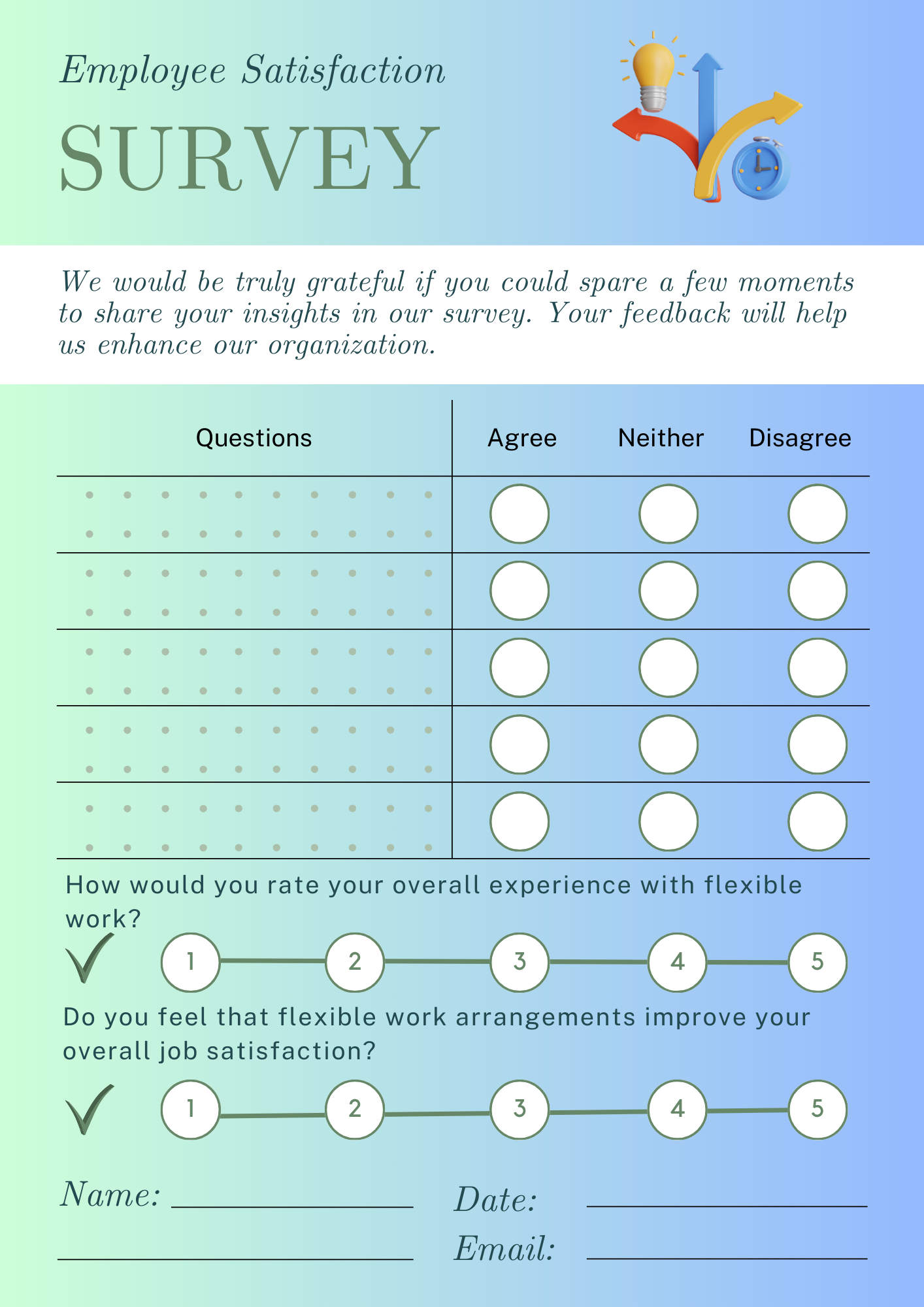
How It Works:
Design: Develop a survey to collect feedback about job happiness and work-life balance to evaluate how well employees feel.
Distribution: Give the survey to every employee who uses our flexible work programs.
Analysis: Find general trends from response data and determine which areas help most and need adjustment.
Example Questions:
How do you like your current work setup?
How well has your routine between work and personal activities worked for you?
What is your current production rate compared to regular office work?
Performance Metrics
How It Works:
Identify KPIs: Pick important performance indicators from your work setting to see how well employees deliver their tasks and produce good results.
Track Data: Exploit software to monitor these metrics as performance develops.
Compare Results: Measure your performance results both before and after flexible work programs became active.
Example KPIs:
Amount of work done during each work week.
Customer satisfaction scores.
Amount of money each employee brings to business.
Attendance Monitoring
Track Attendance: Use data to monitor how often employees report to work and miss work.
Analyze Trends: Check if your employees stay at work more often after you introduce flexibility options.
Correlate with Flexibility: Compare these attendance and absence patterns with your company's introduction of flexible working conditions.
Example Analysis:
Measure sick day use before and after your team gets flexible work schedules.
Keep a record of employees who show up too late or leave early.
Employee Turnover Rates
How It Works:
Track Turnover: Track employee departure statistics both currently and in the past.
Identify Patterns: Check if your flexible work programs help employees stay at their jobs by noticing lower turnover numbers.
Conduct Exit Interviews: When employees depart use exit interviews to understand their reasons and evaluate if flexible work formats contributed to their decision.
Example Analysis:
Check employee departure numbers before and after companies use combined workplace and remote work policies.
Review what exit interview participants share to find important reasons people leave their jobs.
Productivity Monitoring
Implement Tools: Track employee work progress through business software programs and team working platforms.
Analyze Data: Use results to determine team output standards and teamwork success.
Compare Performance: Check how metrics compare to results from standard office work data.
Example Tools:
Project Management Software
Time Tracking Software
Feedback Sessions
How It Works:
Regular Check-ins: Hold regular team meetings where you let staff tell you about the advantages and problems of their flexible work systems.
Gather Insights: Get important feedback from employees to see what works properly and what needs improvement.
Implement Changes: Use information to modify our flexible work policies.
Example Questions:
What key features of the flexible work program help you perform your best?
What obstacles does your present system pose for you.
Customer Feedback
How It Works:
Collect Feedback: Request customer perspectives to learn how they experienced services since flexible work became official.
Analyze Data: Find out how people feel about the service they get and examine if service quality has gone up or down.
Correlate with Flexibility: Use customer opinions to check if our flexible work methods work well.
Example Analysis:
Determine whether customers display more satisfaction using remote work options when you check their responses before and after launch.
Filter customer feedback to find patterns about how services can improve.
Financial Metrics
How It Works:
Track Costs: Track critical financial indicators such as expenditures in the business plus overall expenses plus income.
Analyze Savings: Track the money your business saves when staff use flexible work setups.
Compare Budgets: Study your business finances before and after starting flexible work initiatives.
Example Analysis:
See how much you save on office space and utility bills thanks to more remote work.
Study the money made from remote and hybrid teams over time.
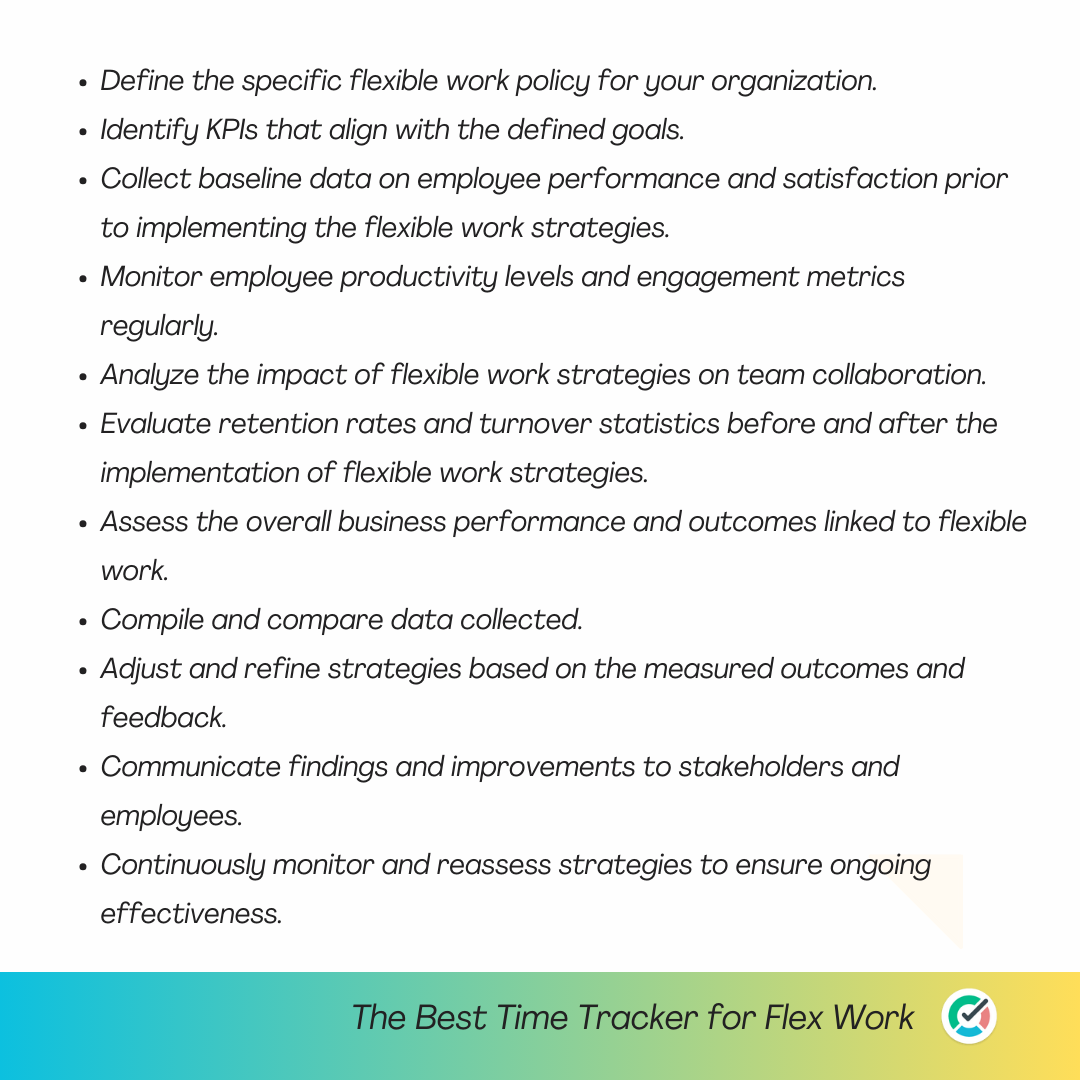
The organization should examine performance data frequently and measure the same indicators across all departments to help build better flexible work practices.
Best Tools to Implement Flexible Work Hours
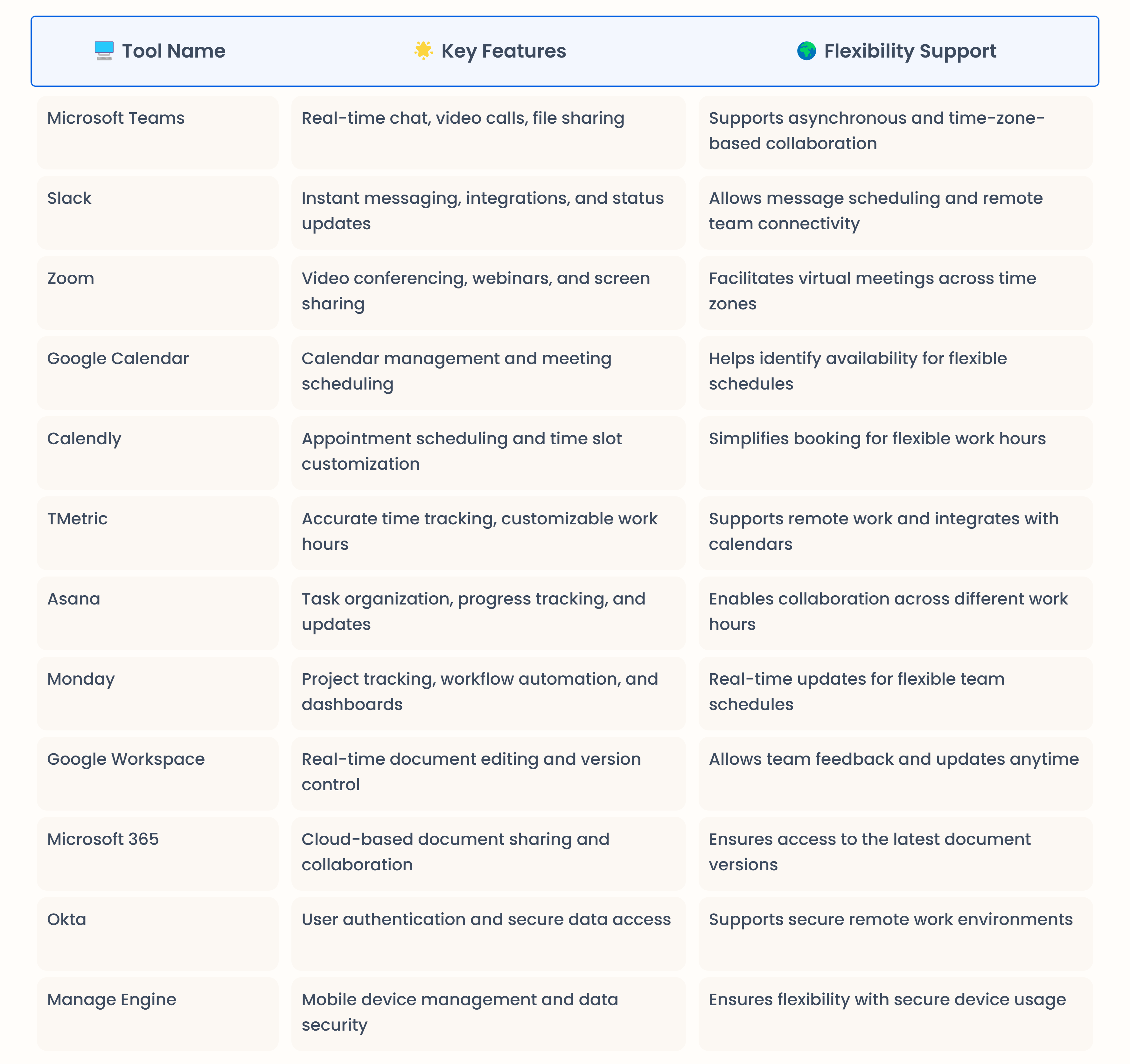
Communication and Collaboration Platforms
The platforms help teams talk and work together in real time as well as in asynchrounous mode through chat messages, video calls and document sharing.
Microsoft Teams Slack and Zoom are top market leaders.
They provide one place where teams can chat instantly through messages video calls and exchange files.
These tools let teams make fast decisions and stay connected during flexible office hours.
Employees can get flexibility by working together from any time zone thanks to status updates and setting message scheduling options.
Time Management and Scheduling
These tools provide effective use of time and meeting planning
The calendar management systems from Google Calendar and Microsoft Outlook help teams identify when their colleagues are available to meet with flexible working schedules.
The scheduling tools When2Meet and Calendly help users set specific work hours for others to easily book appointments.
How to Use TMetric Flexible Work Tool
TMetric time tracker which proved to be the best flex work tool enables users to track their work hours while managing projects during flexible working hours.
The following points describe how it enables staff to work with flexible work hours.
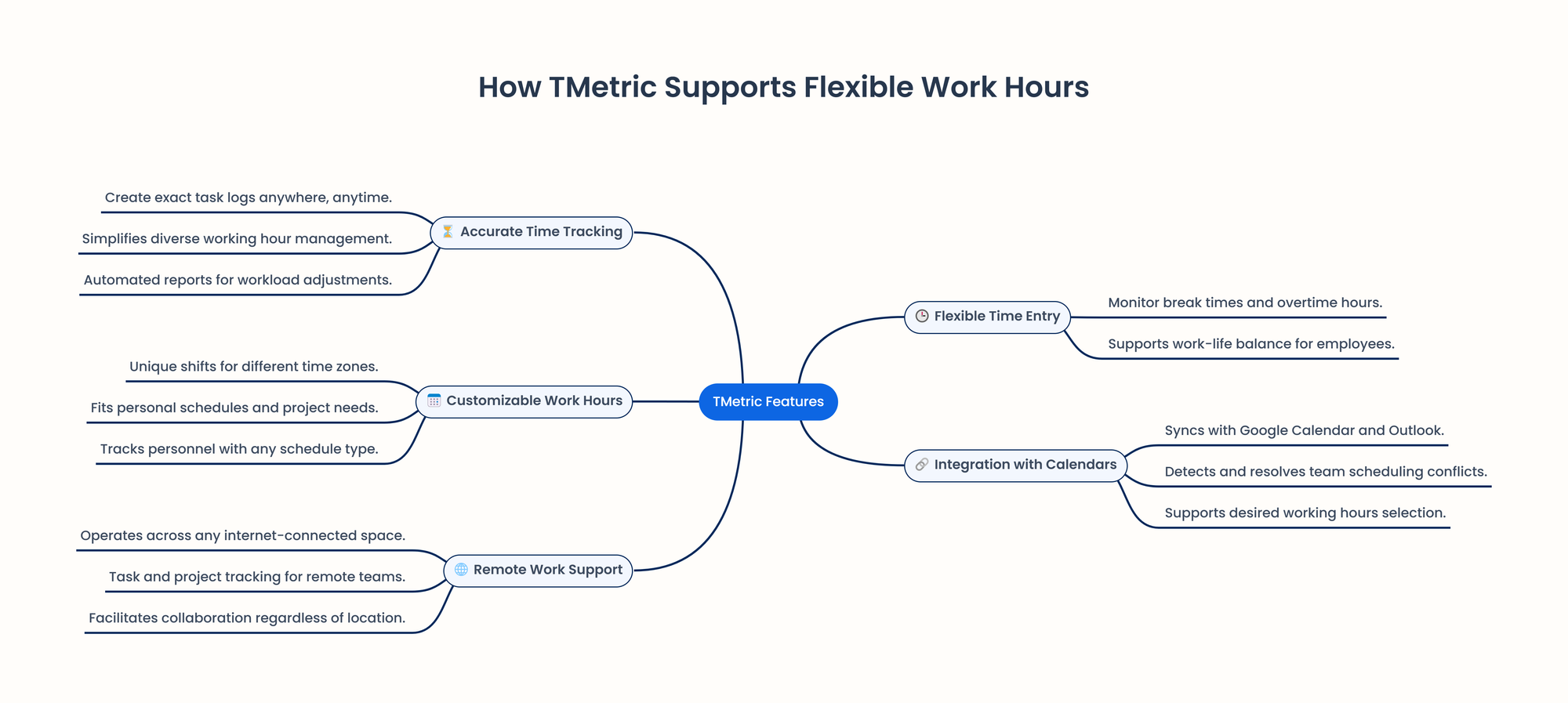
Accurate Time Tracking:
- The system allows workers to create exact task logs without limitations regarding their work locations or work hours.
- It offers complete hour tracking which simplifies the management of diverse working hours.
- Managers receive instant performance data from automated time reports that help adjust workload requirements.
Flexible Time Entry:
- Employees can maintain work-life balance through TMetric because the system helps monitor break times along with overtime hours.
Customizable Work Hours:
- Managers can create unique shifts for workers through their accounts to fit employee time zones along with personal scheduling needs and project responsibilities.
- TMetric is great for shift schedule management because it allows workflow assignment and tracking of personnel with any schedule type during work hours.
Integration with Calendars and Scheduling Tools:
- Employees can view their deadlines through Calendar Sync which supports integration with Google Calendar and Outlook.
- Team scheduling conflicts become detectable and solvable through this tool allowing all staff to select their desired working hours without scheduling interruptions.
Remote Work Support:
- The tool supports remote and hybrid work models because it operates across any internet-connected space.
- Task assignment features in this platform plus project tracking features help workers collaborate regardless of where they are located as well as their work hours.
Project Management Systems
These platforms help teams organize important tasks while displaying their progress to team members working at different times throughout the day.
Online tools like Asana and Monday.com show teams real-time updates for project completion tracking so results stay easy to monitor no matter when work gets done.
Project and productivity tools work together without interruptions.
Document Collaboration Tools
These platforms let everyone on the team see the most recent updates and allows participation even when members work at different times.
Cloud applications from Google Workspace and Microsoft 365 help teams work on documents together in real time while ensuring they work with the latest document versions.
The document collaboration tools make it easy for teams to ask questions and provide feedback right where the document lives.
Secure Access Solutions
These tools ensure the security of information in flexible work settings.
VPN solutions and user identification tools like Okta let employees safely reach company data anywhere and anytime.
Mobile device management tools ( for example, Manage Engine) keep data secure no matter which devices employees use for work and personal tasks.
Time-zone-aware authentication systems (for example, ZygnSec) help companies maintain network security without limiting employee flexibility.
⭐You need to pick tools that fit into your current technology environment easily and work on smartphones, – while implementing tools, show how people use these systems for higher flexibility.



